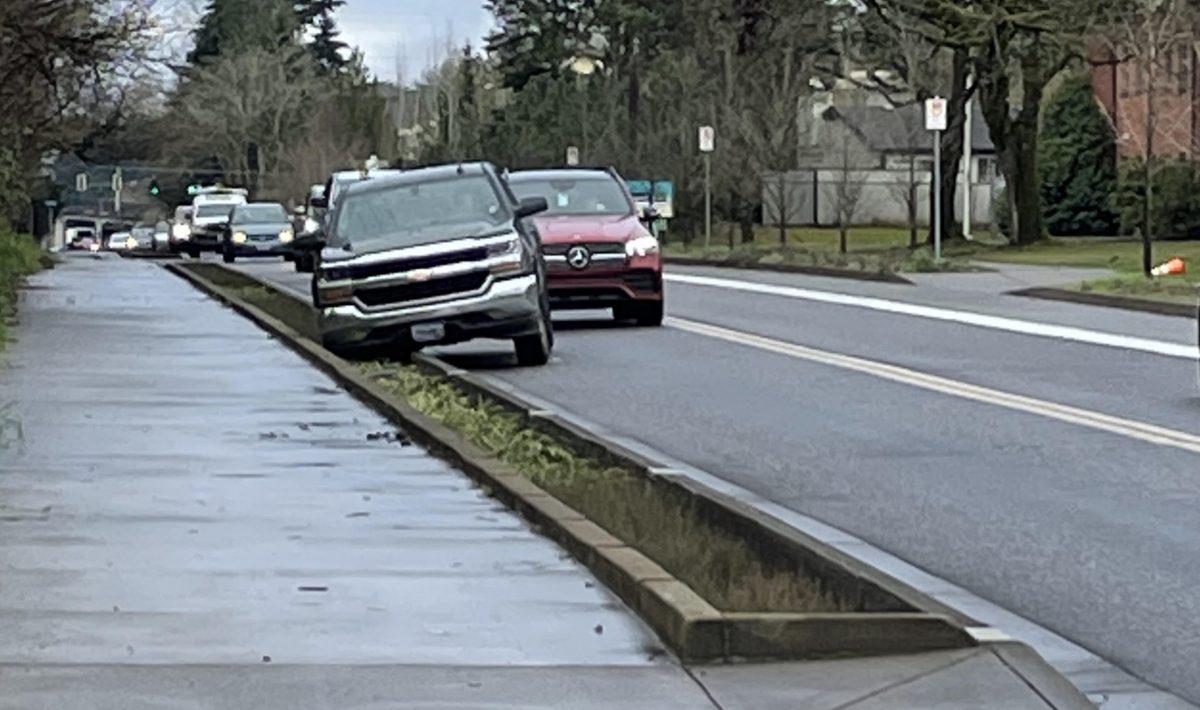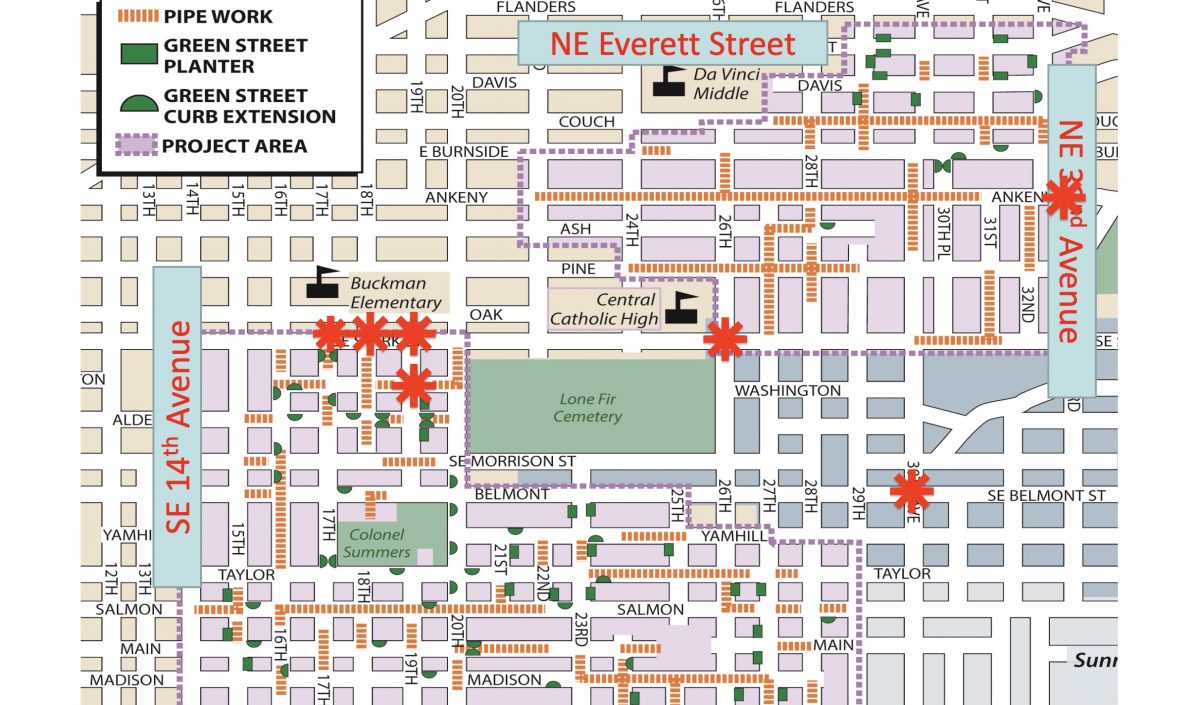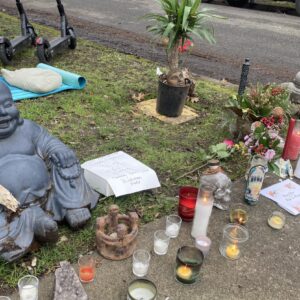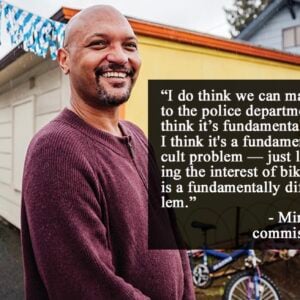
(Photo: Peter S.)
For Portland City Commissioner Mingus Mapps, last week’s intentional vehicular violence in southeast Portland hit very close to home.

“[Jean Gerich] was murdered not a stone’s throw away from where I sit right now,” Mapps shared in remarks during a city council meeting last week as he pointed to a window behind him. “I know people who were injured in this incident and to them I want to say, I am so sorry that happened to you. Please let us know how we can help you heal.”
There are many things we need to do to protect our city from this type of violence. Not knowing exactly what steps to take is not an excuse for doing nothing.
Advertisement
While perusing this week’s city council agenda I saw a ordinance that would authorize construction of the Portland Bureau of Environmental Services (BES) to move forward on their Buckman-Kerns Green Street and Sewer Project, a $24 million investment that will upgrade and install more than four miles of public sewers and build 71 green street planters (a.k.a. bioswales). My jaw hit my desk when I saw the project area map. It covers a near exact footprint of Monday’s crime scene:

And guess which commissioner is in charge of BES? The same one who lives a block away from where Jean Gerich was hit and killed.
I reached out to Commissioner Mapps’ Senior Policy Adviser Matt Glazewski to share my thoughts and make sure their office made the connection.
I was heartened to learn that Glazewski is something of an expert on green streets and stormwater runoff with previous stints at the National Oceanic & Atmospheric Association (NOAA) and Clackamas County Water Environment Services. A year ago he gave a presentation to the Oregon chapter of American Public Works Association titled, Regional Climate Change Effects and Stormwater Facility Resilience.
Advertisement
Glazewski explained how the $24 million Buckman-Kerns green street project will install dozens of curb extensions and will come with new markings and upgraded sidewalks at many locations. “All of that will help with pedestrian visibility,” he said.
With plans already set and construction to begin in a few months, it’s unlikely any changes are possible on this project. But the future might look different.
Let’s rewind a bit.
Some of you might recall when the Bike Plan for 2030 passed in February 2010, it did so without any dedicated funding. That is, until former Mayor Sam Adams stepped up with an idea for collaboration between BES and the Portland Bureau of Transportation that would “kickstart” implementation of the bike plan. Adams wanted to build bike-friendly, traffic-calming elements into green streets that would help manage transportation and stormwater. It became a huge media and political controversy, but council ultimately voted unanimously in support of the idea.
Adams’ office even made a handy video about it (narrated by his transportation policy advisor Catherine Ciarlo who was previously executive director of the Bicycle Transportation Alliance/The Street Trust and is currently manager of the Active Transportation and Safety Division at PBOT):
Portland Green Streets from Sam Adams on Vimeo.
Lest you think this is some Portlandia thing, cities across the globe are using green streets to tame traffic and make streets safer.
Advertisement
“Are there ways we can design things to make it more difficult in the future for these bad things to happen?”
— Matt Glazewski, Mapps’ senior policy adviser
More than a decade later we don’t hear about this PBOT/BES collaboration as much, but maybe it should take on new relevance in light of last week’s carnage. And in light of having a BES commissioner who prefers to walk and bike whenever possible and lives a block from where it happened, now might be a good time to revisit our green street designs.
Glazewski is more than open to that possibility.
“I like to look at these things as opportunities,” he shared on the phone today. “Are there ways we can design things to make it more difficult in the future for these bad things to happen? To enhance the right-of-way to be safer for people using the sidewalks? A way that curbs could be designed that adds any kind of safety for pedestrians? I think that’s something we want to look at for future projects.”
As for the Buckman-Kerns project, Glazewski said the Commissioner’s office wants to install a memorial plaque for Jean Gerich. That would be a nice gesture. Even better would be street designs that offer more protection to against weaponized vehicles.
— Jonathan Maus: (503) 706-8804, @jonathan_maus on Twitter and jonathan@bikeportland.org
— Get our headlines delivered to your inbox.
— Support this independent community media outlet with a one-time contribution or monthly subscription.






Thanks for reading.
BikePortland has served this community with independent community journalism since 2005. We rely on subscriptions from readers like you to survive. Your financial support is vital in keeping this valuable resource alive and well.
Please subscribe today to strengthen and expand our work.
What this article doesn’t cover is that Mapps is managing both the sewer (BES) and water bureaus which together account for over half of the overall city budget. The feds are very generous when it comes to both rebuilding Portland’s aged water infrastructure, most of which is over 100 years old and designed to last 80-100 years when it was built; and dealing with sewerage and preventing raw home sewage from getting into streams and aquifers, with pipes that are equally old and decrepit.
BES is PBOT’s single biggest customer, accounting for a quarter to third of PBOT’s annual budget, mostly for sewer and street maintenance but also periodically for small street rebuilds. When the feds are feeling generous, BES and water both get more federal subsidies and projects than PBOT does, and some of those projects yield either new streets or else street rebuilds.
The biggest cost for most protected bike lane projects is “moving the curb”, that is, moving the sewer gutter and grates to be out of the way of bicycle tires, and to provide protected curb intersections that are designed to both allow people to pass through, and to allow water to do the same during storms, but also to reorient underground pipes, conduits, and electrical lines so they can be accessed for repairs and maintenance. If you have planters in the barrier, why not give them space to grow and be irrigated during the dry summer months? So any street that BES and Water plan to rebuild should be a good potential candidate for “true” protected bike lanes.
exactly! I’m hopeful Mapps makes good on his promise to break down bureau silos and pushes on stuff like this. We all know PBOT needs all the help they can get making streets that protect people from drivers.
I would rather be protected from folks who shoot other people with guns. How many folks have been shot lately? How’s Mike? Twenty-five plus years of riding my bike to work and I am not afraid of cars. People are the problem.
Why either or?
That definitely would include taking more measures to abate vagrancy from bike lanes so that cyclists do not have to weave around into SINGLE LANE travel lane and increasing risk of collision.
Is that what we are calling people parking and leaving stuff in the bike lane now? “Vagrancy”
Sounds a lot more like homeless prejudice.
So this is a really great point David. My biggest worry is that even IF Mapps has the gumption to coordinate with PBoT to start building a network of PBLs, those designs may sometimes end up worse than the baseline. Cully Blvd, for example, makes a great case against involving parks and rec in PBLs due to its abysmally poor design. Protected intersections at high injury commercial intersections should really be the focus in bioswale placement. That’s where the biggest impact will happen.
Really hoping that Mapps and the other commissioners really lead the way on creating safe and beautiful streets. There would be nothing better than a post-covid infrastructure that is inviting to gathering with friends, families and neighbors.
Among the numerous projects built as part of that initial green street program under Adams were the bioswales along Glisan from 128th to 148th, in which city police cars were subsequently hitting at 90 mph with flashing lights off late at night. Apparently they were used to Glisan being an expressway.
How about a Belmont/Stark couplet with protected bike lanes/intersections? A handful of bioswales might be nice, but redesigning entire streets for slow, predictable traffic separated by people on bikes would be transformational. Often a few bioswales and bulbouts are used as a barrier for redesigning entire streets for safety.
What will the bioswales on SE 20th do to a useful but already dicey N-S bike corridor?
Looking at the map, it seems like the only thing on 20th are some curb extension planters adjacent to Col Summers park across from intersecting streets, presumably to make crossing on foot safer (shortening the crossing distance) and providing some traffic calming after cars zoom down the hill from Morrison. Maybe those will go in existing parking spaces? There’s also a really nice parallel neighborhood greenway along SE 16th which is what all the neighborhood folks and commuters use to get to Buckman Elementary, etc.
Also, just to f/u. The location of planters next to Col Summers are likely strategically placed there to help with stormwater. The park is really boggy probably because all the water rushing down to the river. That’s a big reason these improvements are needed in this part of the city. I have streets in my neighborhood (Kerns) that fill up with water that never quite dissipates. We have an incredible tree canopy but becasue it’s a very dense part of the city many people don’t have driveways, and thus on leaf day, cars are left on the street and leaves don’t get cleaned up and perpetually clog the storm drains. City problems!
A bunch of the cross-streets on SE 20th are supposed to be right-turn only and are signed as such, but cars ignore them all the time to go straight across 20th or turn left, particularly when coming off the streets that are close to Hawthorne, Belmont and Morrison intersections. I suppose some kind of mid-street bioswale that makes turning right the only reasonable option is too much to hope for. But even just in terms of vehicle-traffic safety, PBOT should improve that corridor.
That and taking out some of the parking for curb extensions — given that there’s more than enough places to park on the many side streets — would make the street safer for cars, rollers and walkers.
Yes, 16th is nearby, but given all the destinations along 20th this should be a safer avenue.
Answer: bioswales and curb extensions do nothing but preserve curb-side parking and narrow the right of way to the point where it forces cyclists into the path of motor vehicles.
Just wait until a neighborhood association is irked at some design that changes the street layout of some neighbors who don’t like change. Remember what Mapps ran on.
That’s nothing… Wait until the folks here get a look at that design!
Great follow up on this decade long story. I believe Adams called the 2010 investment in Green Streets “a three-fer” for their environmental, safety and cost-saving benefits. The press roasted him at the time. It has taken a decade to vindicate his case. The big challenge with green streets remains investing adequately in their stewardship & maintenance which is an under-appreciated need despite being less costly than maintenance of most grey infrastructure over the longterm.
Thanks Jim. And I remember that “three-fer” thing I just could not get myself to repeat it ;-). And yes he got absolutely destroyed for the “sewer money for bike lanes thing”. It was a great illustration of the moment we were in around bicycling and it was the start of the slide/plateau and decline we’re in the midst of today. As for upkeep… I learned yesterday that folks can adopt the planters. I know that if Hardesty/Mapps worked together on this to make streets safer they could enlist an army of Portlanders to volunteer for adoption.
My assessment is that the City has left too much of the needed stewardship and maintenance of green streets to volunteers. It is great for building community buy-in but insufficient to meet the need currently out there. I believe green street maintenance and stewardship needs to be among a range of green jobs we collectively invest-in for both social and environmental benefits, including the safety benefits.
I routinely see BES employees maintaining the stormwater planters in my neighborhood. I think they look to volunteers to do the sorts of low-hanging maintenance such as removing trash, but I don’t believe they expect volunteers to do the more intense regular maintenance that these planters require.
You are correct on that. But it is exactly that kind of leveraging of public investment that gets the grants.
I hate to contribute to the sort of reverse nimby-ism and me-first attitude thats common right now but what can be so frustrating to the racial justice team, of whom i am at best someone who only plays every few seasons, is consistent de-prioritization of them in infrastructure.
All road improvements in this city which spends so precious little on it, should take a back seat to putting sidewalks and crosswalks in the killing fields east of I-205. I live at the I-205 i refuse to walk on the east side of it, the change in level of safety is palpable, plus driving behavior there is different.
Black and brown people live east of I-205, poor people live there–it is time to help them.
Donel, haven’t you seen the beg buttons and Blinky lights they’ve been installing?
Off topic, but I was in Santa Barbara and Goleta California last month. Walking down a very busy four lane surface street, got to the intersection, pushed the ‘beg’ button and it instantly changed the car signal to yellow. Instantly…they have given priority to peds there. I was shocked…almost felt guilty that I had stopped car traffic….almost. Over here in Bend, pushing the beg button has no effect on car signals, as far as I can tell. The light does not change any faster, all it does is light up the Walk signal. I suppose it might help when there is not car traffic, so no automatic cycling of car signals, but that would be in the middle of the night only…
This is the type of change that is easy/cheap to implement and really starts to change the culture about who gets priority/right of way. This needs to happen here.
Yes, and LPI. It’s a quick and easy fix that adds a lot.
This is BES money – they decide where it’s going to be built, then PBOT does the building under contract. PBOT effectively has no say where projects will be. That said, there are plenty of East Portland projects that used this money in the past and likely will be more coming up. Past examples include 112th south of Powell, near Bush; Glisan east of 122nd; the ODOT outer Powell rebuild (still ongoing); SE 136th; several small projects in the Mt. Scott area of Pleasant Valley; and numerous local streets in Lents near Johnson Creek (100th to 104th).
Two of the issues that influences where these projects are soil drainage and high water tables. SW Portland and Pleasant Valley in outermost SE Portland have large areas of clay soils and need large bioswales much more than other parts of the city. And high water tables along Johnson Creek, such as along outer Powell and outer Foster, and various culverted streams (such as in Goose Hollow and parts of inner East Side) require bioswales to keep runoff from overwhelming existing storm sewers.
Before annexation, Multnomah County built massive storm sewers under the major arterial roadways of East Portland, separating storm water from household sewage, far in advance of inner Portland which is still trying to catch up. The storm sewers use sumps to deal with overflow – the storm sewers themselves effectively act as swales before storm water is dumped into the Columbia River. The vast majority of East Portland is hooked up to a local sewer network that still hasn’t been fully integrated into the old city system. Only a few isolated parts of East Portland still have septic systems.
The green streets have a purpose which is stormwater management. The streets in this neighborhood fill with water coming off mt. tabor rushing to the Willamette. Buckman/Kerns are some of the highest density, diverse neighborhoods in the city. These streets need to be torn up anyway to deal with the sewer pipes which are quite a bit older than those in East Portland (which were done in the 60s!). So why not use it as an opportunity to leave the design better than we found it?
I agree with the storm water management aspect to this post but I’d have to say, the bit about Buckman/Kerns being one of the most diverse neighborhood in the city is downright laughable.
Seriously. Maybe it was that way 50 years ago, but not now (not even close).
https://www.bizjournals.com/portland/news/2019/01/15/wealthiest-neighborhoods-visit-portland-metros-25.html
https://www.niche.com/places-to-live/search/most-diverse-neighborhoods/m/portland-or-metro-area/
BES projects are the most important source of ped/bike improvements in SW Portland. Recent improvements include BH Hwy, Vermont etc. Sometimes it just means adding an extended shoulder, but that makes all the difference in an area where 85% of streets have no sidewalks and the alternative is walking in traffic or on muddy goat trails. The SW Capitol Hwy project also has lots of BES funding.
Where is the pressure from city council upon ODOT for the stroads in Portland? Most people die on the stroads. It is sad what took place with the violence recently in the inner side of southeast, but how about the outer parts of the city?
ODOT only owns a few stroads in Portland; most are city, including most of the most dangerous. And most deaths are on city stroads, including in East Portland. Division, all the numbers other than 82nd, Stark, the diagonal parts of Sandy are all city, as are parts of MLK/Grand that have state highway designations. ODOT is making a lot of progress on outer Powell, one of the most notorious stroads, far more than the city is doing on their stroads, though a thorough rebuild by TriMet and PBOT is scheduled soon for Division.
ODOT has made next to zero progress on Barbur Blvd in the past decade beyond ramps on the “woods” bridges and one or two crosswalks.
I like the new photo at the top of this article, showing how well even a narrow planter protects the sidewalk. It’s infinitely better than plastic wands, or a single curb. It shows going down may be as good or better a protection strategy in many cases than going up with bollards, fences, trees, etc.
I’d like to see a test with a car intentionally being driven over a planter like that onto the sidewalk, to simulate a car veering (accidentally or intentionally) onto the sidewalk. Unless the planter were very shallow, I think the vehicle would bottom out without crossing over it, as it looks like happened in the photo.
And additionally, city / county utility funds are one of the last sources of local funding (post CAL Prop 13 style local initiatives) that allows for planning for the costs of growth vitality (vs being capped at 1% of x) in the PNW. The flexibility all depends on how well the communicated the nexus between the impact of the roadway utility facility onto the stormwater facility / drinking water system…plus what the public rate commission allows. In 2010 it was almost black magic…a black box of sorts…but now folks have more awareness and understanding.
Maybe someday they’ll finally finish repaving Yamhill after all the pipe work they have been doing on that street for the last 5+ years.
I hope I’m wrong, but these planters are almost guaranteed to become trash magnets. Unless they are maintained on a weekly basis, there is no way they can keep up with trash and debris accumulation. Was any money allocated for regular maintenance? A better solution would have been some kind of permeable concrete abutment, although making that attractive would have been a challenge. Over here in Bend, when the City builds a non-standard structure like this, it invariably ends up becoming an eyesore within a year. Most street maintenance machines cannot clean them, and the manual labor required is just not in the City budget.
That’s where community volunteer groups and neighborhood associations become useful. I know there’s a “friends of 102nd” group that helps clean the bioswales along there and I’ve heard of others. Some jurisdictions even post blue signs on city streets, as along highways, saying who has taken on responsibility for cleaning the swales.